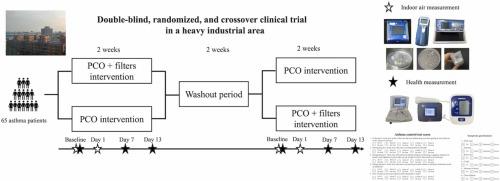Enhancing indoor air quality and cardiopulmonary health in patients with asthma by photocatalytic oxidation and filters air cleaner
IF 12.2
1区 环境科学与生态学
Q1 ENGINEERING, ENVIRONMENTAL
引用次数: 0
Abstract
Background
Air purifiers can enhance indoor air quality and health outcomes, and studies have primarily focused on filters and particulate matter (PM) in households. Photocatalytic oxidation (PCO) is a promising technique for eliminating gaseous pollutants and bioaerosols. However, no field study was conducted in household. Therefore, this study evaluated the effects of the PCO and PCO + filters intervention on indoor air pollutants and cardiopulmonary endpoints in households.Methods
A randomized, double-blind crossover clinical trial was conducted. Indoor air pollutants, including PM, bioaerosols, and gaseous pollutants and cardiopulmonary endpoints including lung function, fractional exhaled nitric oxide (FeNO), respiratory symptoms, and blood pressure were assessed before and after intervention.Findings
This was the first study to evaluate the effects of PCO and PCO + filters interventions on indoor air pollutants and cardiopulmonary health in households. Indoor total volatile organic compounds (TVOC) and sulfur dioxides (SO2) significantly reduced after PCO intervention, however, we also observed the significant reduction in percentage of predicted values of forced vital capacity (FVC%) and forced expiratory volume in 3 s (FEV3%) and increased in FeNO after 13 days of PCO intervention. The PCO + filters intervention significantly reduced the levels of indoor PM1, PM2.5, PM4, PM10, total suspended particulate matter, ultrafine particles, airborne bacteria, fungi, endotoxin, mites, TVOC, nitrogen dioxide, and SO2, and marginal reduction in carbon monoxide. However, indoor carbon dioxide significantly increased after PCO/PCO + filters intervention. As for cardiopulmonary health, FVC%, and FEV1% marginally increased 7 days after the PCO + filters intervention.

光催化氧化和过滤器空气净化器改善哮喘患者的室内空气质量和心肺健康
背景空气净化器可以改善室内空气质量和健康状况,研究主要集中在家用过滤器和颗粒物质(PM)上。光催化氧化(PCO)是一种消除气态污染物和生物气溶胶的有效技术。然而,尚未在家庭中进行实地研究。因此,本研究评估了 PCO 和 PCO + 过滤器干预措施对家庭室内空气污染物和心肺终点的影响。对干预前后的室内空气污染物(包括可吸入颗粒物、生物气溶胶和气态污染物)和心肺终点(包括肺功能、呼出一氧化氮(FeNO)分数、呼吸道症状和血压)进行了评估。室内总挥发性有机化合物(TVOC)和二氧化硫(SO2)在 PCO 干预后显著减少,然而,我们还观察到,在 PCO 干预 13 天后,强迫肺活量(FVC%)和 3 秒内强迫呼气量(FEV3%)的预测值百分比显著降低,而 FeNO 增加。PCO + 过滤器干预显著降低了室内 PM1、PM2.5、PM4、PM10、总悬浮颗粒物、超细颗粒物、空气传播的细菌、真菌、内毒素、螨虫、TVOC、二氧化氮和二氧化硫的水平,一氧化碳也略有降低。然而,PCO/PCO + 过滤器干预后,室内二氧化碳明显增加。在心肺健康方面,PCO + 过滤网干预 7 天后,FVC% 和 FEV1% 略有增加。
本文章由计算机程序翻译,如有差异,请以英文原文为准。
求助全文
约1分钟内获得全文
求助全文
来源期刊

Journal of Hazardous Materials
工程技术-工程:环境
CiteScore
25.40
自引率
5.90%
发文量
3059
审稿时长
58 days
期刊介绍:
The Journal of Hazardous Materials serves as a global platform for promoting cutting-edge research in the field of Environmental Science and Engineering. Our publication features a wide range of articles, including full-length research papers, review articles, and perspectives, with the aim of enhancing our understanding of the dangers and risks associated with various materials concerning public health and the environment. It is important to note that the term "environmental contaminants" refers specifically to substances that pose hazardous effects through contamination, while excluding those that do not have such impacts on the environment or human health. Moreover, we emphasize the distinction between wastes and hazardous materials in order to provide further clarity on the scope of the journal. We have a keen interest in exploring specific compounds and microbial agents that have adverse effects on the environment.
 求助内容:
求助内容: 应助结果提醒方式:
应助结果提醒方式:


